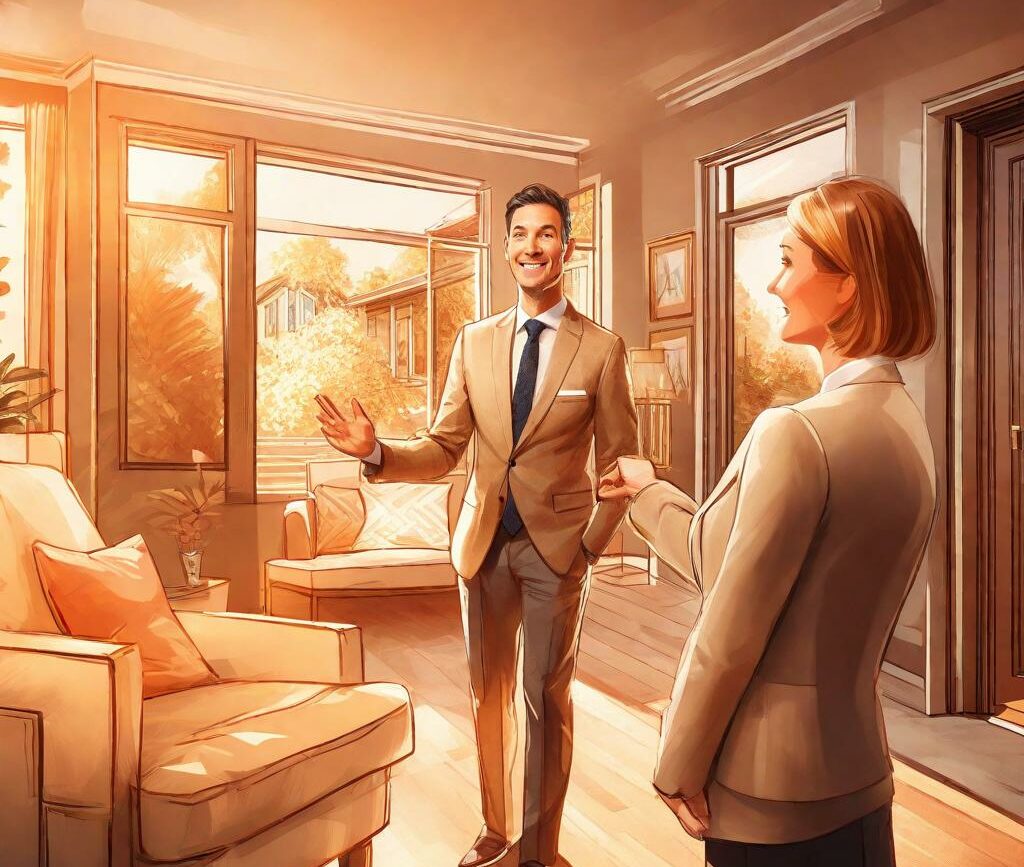Virtual tours are immersive digital experiences that allow potential buyers to explore a property remotely. These tours provide a comprehensive view of the property, showcasing its various features, layout, and ambiance. By incorporating high-quality visuals, interactive elements, and sometimes even virtual reality technology, virtual tours aim to offer a realistic and engaging experience to potential buyers.
b. Evolution and popularity of virtual tours in the industry
Virtual tours have gained tremendous popularity in the real estate industry in recent years. As technology continues to advance, so does the demand for innovative ways to market properties. Virtual tours have become a powerful tool for estate agents, providing a unique and effective way to showcase properties to a wider audience. With the convenience they offer in terms of remote viewing and the ability to showcase multiple properties in a short amount of time, virtual tours have become a game-changer in the real estate market.
c. Benefits of using virtual tours for estate agents
Estate agents who utilize virtual tours as part of their marketing strategies can reap numerous benefits. Firstly, virtual tours enhance property visualization, allowing potential buyers to get a realistic sense of the property’s layout, size, and overall appeal. This ultimately leads to increased engagement and interest from potential buyers.
Moreover, virtual tours help build trust and credibility with potential buyers. By providing an immersive experience that allows buyers to explore the property at their own pace, estate agents can showcase every nook and cranny of the property, leaving no room for doubt or skepticism. Virtual tours also give estate agents the opportunity to differentiate themselves from their competitors in a crowded market by offering a unique and modern way of presenting properties.
Changing Landscape of Real Estate Marketing
a. Traditional vs. contemporary real estate marketing strategies
Traditionally, real estate marketing relied heavily on print advertisements, flyers, and open houses. While these methods still have their place in the industry, the rise of digital platforms and the increasing preference for online property searches have prompted estate agents to adopt more contemporary marketing strategies. Virtual tours have emerged as a crucial component of these strategies, revolutionizing the way properties are marketed and experienced by potential buyers.
b. Impact of virtual tours on property listings
The inclusion of virtual tours in property listings has had a significant impact on the real estate market. According to research, listings with virtual tours receive significantly more views and engagement compared to those without. Potential buyers are drawn to the interactive and immersive nature of virtual tours, as they allow for a more detailed and realistic exploration of the property. This increased engagement ultimately translates into more traffic, leads, and ultimately, more sales for estate agents.
c. Rising consumer expectations and the need for virtual tours
With the rise of technology and the increasing prevalence of online property searches, consumer expectations have also evolved. Potential buyers now expect more than just static images and basic property descriptions. They want an experience that closely resembles an in-person property visit. Virtual tours fulfill this need by providing a dynamic and interactive experience that meets the expectations of today’s tech-savvy buyers.
Importance of Virtual Tours for Estate Agents
a. Enhancing property visualization and engagement
One of the key reasons why virtual tours have become an essential tool for estate agents is their ability to enhance property visualization. Unlike static images or written descriptions, virtual tours provide a comprehensive and immersive experience that allows potential buyers to imagine themselves in the property. By showcasing the property from all angles and providing interactive features like zooming in on specific details or taking virtual walks through each room, virtual tours enable buyers to truly visualize themselves living in the space.
b. Building trust and credibility with potential buyers
In the highly competitive real estate market, building trust and credibility with potential buyers is crucial. Virtual tours help achieve this by offering a transparent and authentic representation of the property. Potential buyers can explore the property at their own pace, without feeling rushed or pressured. This transparency helps establish trust between the estate agent and the buyer, as it shows that the agent has nothing to hide and is confident in the quality and appeal of the property.
c. Differentiating from competitors in a crowded market
With virtual tours becoming more popular, it is becoming increasingly important for estate agents to differentiate themselves from their competitors. A virtual tour can be the key factor that sets an agent’s listings apart from the competition. By offering potential buyers an immersive experience that goes beyond static images, estate agents can capture the attention and interest of buyers who are bombarded with numerous property listings. This differentiation can make all the difference in attracting potential buyers and ultimately closing sales.
Utilizing Virtual Tours to Drive Traffic
Optimizing Virtual Tours for Online Platforms
To maximize the impact of virtual tours, estate agents need to ensure they are optimized for online platforms. This starts with choosing the right virtual tour software or service that aligns with the agent’s needs and goals. The software should allow for the seamless integration of high-quality visuals and interactive features, ensuring that potential buyers have a smooth and engaging experience.
In addition, compatibility across devices and platforms is crucial. Virtual tours should be accessible and fully functional on a variety of devices, including smartphones, tablets, and desktop computers. This ensures that potential buyers can view the virtual tour regardless of the device they are using, increasing the reach and accessibility of the property listing.
Integrating Virtual Tours with Online Listing Portals
To drive traffic and exposure, it is important for estate agents to integrate virtual tours with popular online listing portals. These portals attract a large number of potential buyers, providing a platform for estate agents to showcase their properties. By including virtual tours within their property listings on these portals, estate agents can significantly increase the visibility and engagement of their listings.
Furthermore, estate agents can enhance their listing presentations by incorporating virtual tours. This not only captures the attention of potential buyers but also demonstrates the agent’s commitment to utilizing innovative and effective marketing strategies. Social media platforms can also be leveraged to further amplify the reach and exposure of virtual tours, providing an additional avenue for estate agents to attract a wider audience.
Harnessing SEO for Virtual Tours
To ensure that virtual tours gain maximum exposure, it is essential to optimize them for search engine visibility and ranking. This can be done through the strategic incorporation of targeted keywords and descriptions within the virtual tour content. By using relevant and popular keywords that potential buyers are likely to search for, estate agents can increase the chances of their virtual tours appearing in search engine results.
However, optimizing virtual tours for SEO can be a complex process. Collaborating with digital marketing experts can provide estate agents with valuable insights and strategies to maximize the impact of their virtual tours. These experts can analyze search trends, identify relevant keywords, and develop a comprehensive SEO strategy to drive maximum traffic and leads to the virtual tours.
Generating Leads through Virtual Tours
Crafting Compelling Call-to-Actions (CTAs)
To generate leads effectively, estate agents must strategically place compelling call-to-actions (CTAs) within their virtual tours. CTAs can be placed at strategic points within the tour, such as when showcasing a particularly attractive feature or when highlighting the unique selling points of the property. These CTAs should be visually appealing and action-driven, prompting potential buyers to take further steps, such as contacting the estate agent for more information or scheduling a property viewing.
Optimizing CTAs to capture and convert leads effectively requires careful consideration of the design, placement, and messaging. CTAs should be visually distinct and easy to spot within the virtual tour. The messaging should be concise, persuasive, and clearly communicate the desired action. By strategically positioning and optimizing CTAs, estate agents can maximize lead generation and conversion rates.
Collecting User Data for Lead Generation
Incorporating lead capture forms within virtual tours is an effective way to collect user data for lead generation. These forms can be strategically placed within the virtual tour, prompting potential buyers to provide their contact information in exchange for more information or exclusive offers related to the property. However, it’s important to strike a balance between user experience and lead collection. Lead capture forms should be seamlessly integrated into the virtual tour without disrupting the overall experience. Users should be able to easily navigate through the tour and submit their information without any friction.
Integrating Customer Relationship Management (CRM) systems can further streamline the lead management process. By connecting virtual tour lead data with CRM systems, estate agents can effectively track, manage, and nurture leads for future follow-ups and conversions.
Personalizing Virtual Tours for Targeted Leads
Segmenting leads based on their preferences and demographics allows estate agents to personalize virtual tours and cater to specific buyer personas. By understanding the unique needs and desires of potential buyers, estate agents can customize virtual tours to showcase features and highlights that are most relevant and appealing to each target audience. This personalization creates a stronger connection with potential buyers and increases the likelihood of lead conversion.
Advanced analytics can be utilized to refine and improve lead generation strategies. By analyzing data such as virtual tour engagement, conversion rates, and user behavior, estate agents gain valuable insights into the effectiveness of their virtual tours. This information can be used to make data-driven decisions and optimize future lead generation strategies for even better results.
Amplifying Sales with Virtual Tours
Enhancing Property Showings and Tours
Virtual tours can be offered as a pre-qualifying tool, allowing potential buyers to explore the property remotely before committing to an in-person showing. By providing an immersive and detailed virtual tour experience, estate agents can attract serious and genuinely interested buyers, saving both parties time and effort. Virtual tours also facilitate remote or long-distance property viewings, eliminating geographical limitations and enabling buyers to explore properties that they otherwise may not have considered.
Moreover, virtual tours contribute to increased convenience and efficiency for both estate agents and buyers. Instead of scheduling multiple property showings, agents can use virtual tours to showcase multiple properties to potential buyers in a short amount of time. This saves valuable time for all parties involved and increases the chances of finding the perfect match between a buyer and a property.
Nurturing Prospects with Virtual Tours
Virtual tours offer estate agents an opportunity to nurture prospects by leveraging storytelling and emotional connection. By incorporating interactive elements and immersive experiences within the virtual tour, estate agents can create a narrative that captivates potential buyers. Agents can highlight unique features, share the history or significance of the property, and create an emotional connection between the buyer and the property. This emotional connection plays a vital role in nurturing prospects, as it fosters a sense of attachment and makes the property more memorable and desirable.
Furthermore, virtual tours allow for interactive elements that showcase property features in a unique and engaging way. Potential buyers can interact with the virtual tour, exploring every aspect of the property and experiencing it on a deeper level. This interactivity further enhances the emotional connection and facilitates a more meaningful and impactful property viewing experience.
Expanding Conversion Opportunities
Virtual tours can be leveraged for cross-selling and upselling purposes. By showcasing related properties or additional features and amenities within the virtual tour, estate agents can introduce potential buyers to other properties that may be of interest. This not only expands the range of options available to potential buyers but also increases the chances of upselling by highlighting premium or upgraded features.
Integrating virtual tours within email marketing campaigns can also significantly contribute to conversion opportunities. Estate agents can include virtual tour links within email newsletters or property updates, inviting potential buyers to explore the properties at their own convenience. This provides an additional touchpoint for engagement and increases the likelihood of conversion by keeping the properties at the top of buyers’ minds.
Tracking and analyzing virtual tour engagement is crucial for targeted follow-ups. By monitoring how potential buyers interact with the virtual tour, estate agents can gain insights into their preferences, interests, and intentions. This information can then be used to tailor follow-up communications and provide personalized, relevant information to potential buyers.
V. Summary and FAQs

Virtual tours have emerged as a powerful tool for estate agents, revolutionizing the way properties are marketed and experienced by potential buyers. By providing immersive and interactive experiences, virtual tours enhance property visualization, build trust and credibility, and differentiate estate agents from their competitors.
Optimizing virtual tours for online platforms, integrating them with online listing portals, and harnessing SEO strategies can drive traffic and maximize exposure. Crafting compelling CTAs, collecting user data, and personalizing virtual tours help generate leads effectively. Enhancing property showings, nurturing prospects, and expanding conversion opportunities contribute to amplifying sales with virtual tours.
In summary, estate agents can unlock the power of virtual tours by embracing innovative technologies, personalizing the experience for potential buyers, and leveraging virtual tours as a secret weapon to increase traffic, leads, and ultimately, sales.
FAQs about Virtual Tours in Real Estate
Q: Are virtual tours only suitable for high-end or luxury properties?
A: Not at all. Virtual tours can be utilized for properties of all types and price ranges. Whether it’s a modest family home or a luxurious estate, virtual tours offer a unique and engaging way to showcase the property to potential buyers.
Q: Do I need to hire a professional to create virtual tours for my properties?
A: While professional services are available, there are also user-friendly virtual tour software options that allow estate agents to create their own virtual tours without specialized technical skills. These tools often provide step-by-step guidance and templates to simplify the process.
Q: Can virtual tours replace in-person property viewings?
A: Virtual tours can be an effective pre-qualifying tool, allowing potential buyers to explore the property remotely and decide if it aligns with their preferences. However, in-person property viewings still play a crucial role in the buying process, as they provide the opportunity for a hands-on experience and deeper inspection of the property.
Q: Are virtual tours expensive to create?
A: The cost of creating virtual tours can vary depending on factors such as the complexity of the tour, the software or service used, and whether professional photography or videography is involved. However, with the availability of user-friendly virtual tour software options, estate agents can create affordable virtual tours that offer a high level of quality and engagement.
Q: Can virtual tours be shared on social media platforms?
A: Yes, virtual tours can be easily shared on various social media platforms. By sharing virtual tours on platforms like Facebook, Instagram, or LinkedIn, estate agents can reach a wider audience and attract potential buyers who may not have come across the property through traditional listing portals.
Q: Will virtual tours replace traditional property marketing methods entirely?
A: While virtual tours have reshaped the real estate marketing landscape, traditional methods still have their place. Print advertisements, open houses, and property brochures continue to play a role, especially for local marketing and attracting buyers who prefer a more traditional approach. However, incorporating virtual tours into the marketing strategy allows estate agents to stay ahead of the curve and cater to the evolving preferences of their clients.





